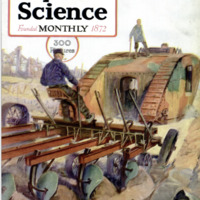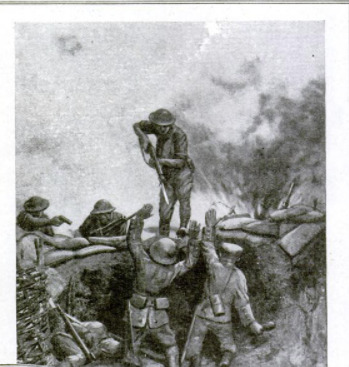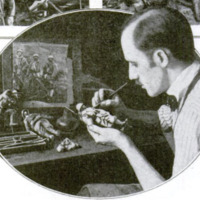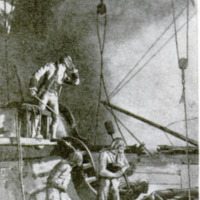A New York artist realistically represents World War I battles an other historical events
Item
-
Title (Dublin Core)
-
A New York artist realistically represents World War I battles an other historical events
-
Article Title and/or Image Caption (Dublin Core)
-
Scientist and Artist Too
-
extracted text (Extract Text)
-
DWIGHT FRANKLIN, of
New York city, is a new
kind of artist. Perhaps he
ought to be called a new kind of scientist,
too. He delves into the hidden past by making
a thorough scientific study of how the cave-man lived,
how the Vikings fought, how George Washington crossed |
the Delaware, or how the pirates of the Spanish Main |
spread terror in the Caribbean Sea, all for the purpose of
producing startlingly realistic and minutely accurate |
models.
Now, the model is not a new piece of apparatus in the |
museum; but in the past it has been both accurate and dead.
Dwight Franklin imparts to the model dramatic action.
He applies, on a small scale, the very principles that David
Belasco and other successful producers of plays employ |
to stir the souls of their audiences.
‘What is the most striking event in the career of John |
Paul Jones? Undoubtedly, that historic battle during |
which he stood on the quarter-deck of the Bonhomme |
Richard, when it had been reduced to a mere hulk, and |
responded to his British adversary’s demand for surrender |
with: “I have only just begun to fight!” |
Dwight Franklin dramatizes
the incident. He makes a model
of the deck. He places on the deck
little figures, fashioned with a real artist's
feeling and with a jeweler's painstaking regard
for minute detail. In a word, he stages John Paul
Jones and his crew. He mounts the setting in a box,
like a little stage, and illuminates it with a keen sense
for the dramatic effect. And theresult? The scene lives.
As yet Mr. Franklin has no competitor in his scientific
dramatizations. His work, exhibited in the Metropolitan
Museum of Art and in the American Museum of Natural
History, finds no counterpart anywhere.
Franklin has had to create his own technique. Plaster,
wood, clay, cardboard, metal—all materials must be
worked with equal skill and facility in order to produce the
effect desired. He will spend hours, even days, in carving
and piecing together a little chair. If the charred ruin of
French village razed by German gunsis to be represented,
he will first fashion little beams and then burn them.
Thus a new step has been taken by a man who com-
bines the plastic sense of the sculptor with the scientist's
love of truth.
-
Language (Dublin Core)
-
eng
-
Date Issued (Dublin Core)
-
1919-02
-
pages (Bibliographic Ontology)
-
60
-
Rights (Dublin Core)
-
Public domain (Google digitized)
-
Archived by (Dublin Core)
-
Davide Donà
-
Marco Bortolami (editor)
 Popular Science Monthly, v. 94, n. 2, 1919
Popular Science Monthly, v. 94, n. 2, 1919






